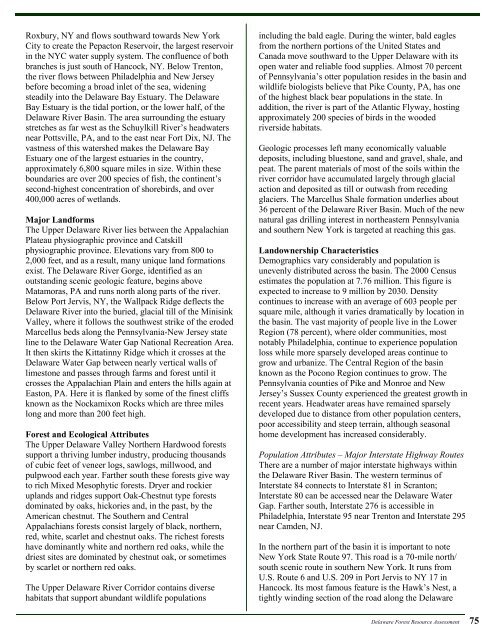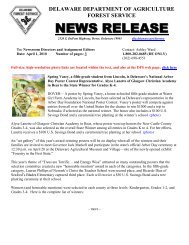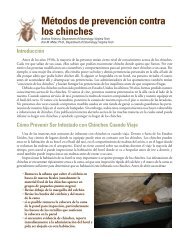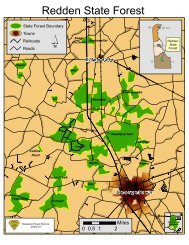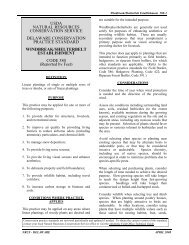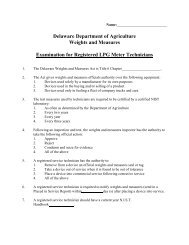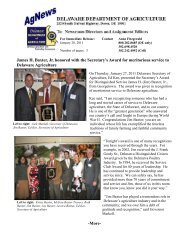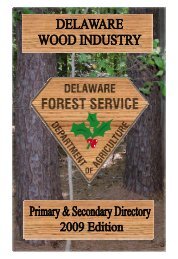DFS Resource Assessment - Delaware Department of Agriculture
DFS Resource Assessment - Delaware Department of Agriculture
DFS Resource Assessment - Delaware Department of Agriculture
Create successful ePaper yourself
Turn your PDF publications into a flip-book with our unique Google optimized e-Paper software.
Roxbury, NY and flows southward towards New York<br />
City to create the Pepacton Reservoir, the largest reservoir<br />
in the NYC water supply system. The confluence <strong>of</strong> both<br />
branches is just south <strong>of</strong> Hancock, NY. Below Trenton,<br />
the river flows between Philadelphia and New Jersey<br />
before becoming a broad inlet <strong>of</strong> the sea, widening<br />
steadily into the <strong>Delaware</strong> Bay Estuary. The <strong>Delaware</strong><br />
Bay Estuary is the tidal portion, or the lower half, <strong>of</strong> the<br />
<strong>Delaware</strong> River Basin. The area surrounding the estuary<br />
stretches as far west as the Schuylkill River’s headwaters<br />
near Pottsville, PA, and to the east near Fort Dix, NJ. The<br />
vastness <strong>of</strong> this watershed makes the <strong>Delaware</strong> Bay<br />
Estuary one <strong>of</strong> the largest estuaries in the country,<br />
approximately 6,800 square miles in size. Within these<br />
boundaries are over 200 species <strong>of</strong> fish, the continent’s<br />
second-highest concentration <strong>of</strong> shorebirds, and over<br />
400,000 acres <strong>of</strong> wetlands.<br />
Major Landforms<br />
The Upper <strong>Delaware</strong> River lies between the Appalachian<br />
Plateau physiographic province and Catskill<br />
physiographic province. Elevations vary from 800 to<br />
2,000 feet, and as a result, many unique land formations<br />
exist. The <strong>Delaware</strong> River Gorge, identified as an<br />
outstanding scenic geologic feature, begins above<br />
Matamoras, PA and runs north along parts <strong>of</strong> the river.<br />
Below Port Jervis, NY, the Wallpack Ridge deflects the<br />
<strong>Delaware</strong> River into the buried, glacial till <strong>of</strong> the Minisink<br />
Valley, where it follows the southwest strike <strong>of</strong> the eroded<br />
Marcellus beds along the Pennsylvania-New Jersey state<br />
line to the <strong>Delaware</strong> Water Gap National Recreation Area.<br />
It then skirts the Kittatinny Ridge which it crosses at the<br />
<strong>Delaware</strong> Water Gap between nearly vertical walls <strong>of</strong><br />
limestone and passes through farms and forest until it<br />
crosses the Appalachian Plain and enters the hills again at<br />
Easton, PA. Here it is flanked by some <strong>of</strong> the finest cliffs<br />
known as the Nockamixon Rocks which are three miles<br />
long and more than 200 feet high.<br />
Forest and Ecological Attributes<br />
The Upper <strong>Delaware</strong> Valley Northern Hardwood forests<br />
support a thriving lumber industry, producing thousands<br />
<strong>of</strong> cubic feet <strong>of</strong> veneer logs, sawlogs, millwood, and<br />
pulpwood each year. Farther south these forests give way<br />
to rich Mixed Mesophytic forests. Dryer and rockier<br />
uplands and ridges support Oak-Chestnut type forests<br />
dominated by oaks, hickories and, in the past, by the<br />
American chestnut. The Southern and Central<br />
Appalachians forests consist largely <strong>of</strong> black, northern,<br />
red, white, scarlet and chestnut oaks. The richest forests<br />
have dominantly white and northern red oaks, while the<br />
driest sites are dominated by chestnut oak, or sometimes<br />
by scarlet or northern red oaks.<br />
The Upper <strong>Delaware</strong> River Corridor contains diverse<br />
habitats that support abundant wildlife populations<br />
including the bald eagle. During the winter, bald eagles<br />
from the northern portions <strong>of</strong> the United States and<br />
Canada move southward to the Upper <strong>Delaware</strong> with its<br />
open water and reliable food supplies. Almost 70 percent<br />
<strong>of</strong> Pennsylvania’s otter population resides in the basin and<br />
wildlife biologists believe that Pike County, PA, has one<br />
<strong>of</strong> the highest black bear populations in the state. In<br />
addition, the river is part <strong>of</strong> the Atlantic Flyway, hosting<br />
approximately 200 species <strong>of</strong> birds in the wooded<br />
riverside habitats.<br />
Geologic processes left many economically valuable<br />
deposits, including bluestone, sand and gravel, shale, and<br />
peat. The parent materials <strong>of</strong> most <strong>of</strong> the soils within the<br />
river corridor have accumulated largely through glacial<br />
action and deposited as till or outwash from receding<br />
glaciers. The Marcellus Shale formation underlies about<br />
36 percent <strong>of</strong> the <strong>Delaware</strong> River Basin. Much <strong>of</strong> the new<br />
natural gas drilling interest in northeastern Pennsylvania<br />
and southern New York is targeted at reaching this gas.<br />
Landownership Characteristics<br />
Demographics vary considerably and population is<br />
unevenly distributed across the basin. The 2000 Census<br />
estimates the population at 7.76 million. This figure is<br />
expected to increase to 9 million by 2030. Density<br />
continues to increase with an average <strong>of</strong> 603 people per<br />
square mile, although it varies dramatically by location in<br />
the basin. The vast majority <strong>of</strong> people live in the Lower<br />
Region (78 percent), where older communities, most<br />
notably Philadelphia, continue to experience population<br />
loss while more sparsely developed areas continue to<br />
grow and urbanize. The Central Region <strong>of</strong> the basin<br />
known as the Pocono Region continues to grow. The<br />
Pennsylvania counties <strong>of</strong> Pike and Monroe and New<br />
Jersey’s Sussex County experienced the greatest growth in<br />
recent years. Headwater areas have remained sparsely<br />
developed due to distance from other population centers,<br />
poor accessibility and steep terrain, although seasonal<br />
home development has increased considerably.<br />
Population Attributes – Major Interstate Highway Routes<br />
There are a number <strong>of</strong> major interstate highways within<br />
the <strong>Delaware</strong> River Basin. The western terminus <strong>of</strong><br />
Interstate 84 connects to Interstate 81 in Scranton;<br />
Interstate 80 can be accessed near the <strong>Delaware</strong> Water<br />
Gap. Farther south, Interstate 276 is accessible in<br />
Philadelphia, Interstate 95 near Trenton and Interstate 295<br />
near Camden, NJ.<br />
In the northern part <strong>of</strong> the basin it is important to note<br />
New York State Route 97. This road is a 70-mile north/<br />
south scenic route in southern New York. It runs from<br />
U.S. Route 6 and U.S. 209 in Port Jervis to NY 17 in<br />
Hancock. Its most famous feature is the Hawk’s Nest, a<br />
tightly winding section <strong>of</strong> the road along the <strong>Delaware</strong><br />
<strong>Delaware</strong> Forest <strong>Resource</strong> <strong>Assessment</strong> 75


